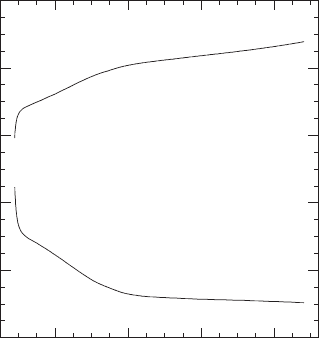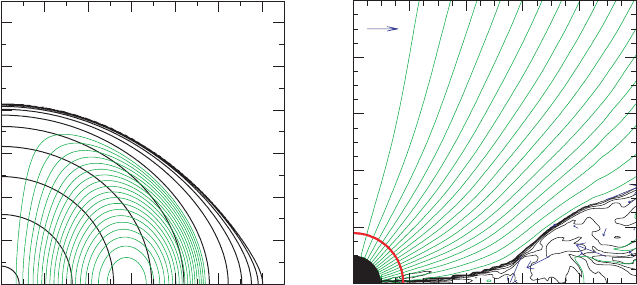Baumgarte T., Shapiro S. Numerical Relativity. Solving Einstein’s Equations on the Computer
Подождите немного. Документ загружается.


14.2 Evolution: instabilities and collapse 501
0
1
0.8
0.6
0.4
0.2
68
70
72
74
t / P
c
M
0
(r > r
AH
)/M
M
irr
/M
Figure 14.15 Evolution of the irreducible mass and the total rest mass outside the apparent horizon. [From
Duez et al. (2006a).]
gamma-ray burst source.
91
They have followed up this suggestion by performing fur-
ther simulations with a more realistic nuclear EOS, and these appear to strengthen the
argument.
92
It is interesting to compare the evolution and final fate of a magnetized hypermassive star
with dynamically stable, differentially rotating, magnetized stars that are not hypermassive.
Consider two distinct categories of differentially rotating, nonhypermassive configurations:
(1) “normal stars”, which have rest masses below the maximum achievable with uniform
rotation, and angular momentum below the maximum for uniform rotation at the same
rest mass, and (2) “ultraspinning stars”, which have angular momentum exceeding the
maximum for uniform rotation at the same rest mass. Suppose they are again threaded by
a weak, initially poloidal magnetic field with C = max(b
2
/P) = 2.5 × 10
−3
. Simulations
in axisymmetry
93
show that a normal star evolves to a uniformly rotating equilibrium
configuration. By contrast, an ultraspinning star cannot settle into a uniformly rotating
equilibrium state. Instead, it evolves to an equilibrium configuration consisting of a nearly
uniformly rotating central core, surrounded by a differentially rotating torus characterized
by an angular velocity that is constant along magnetic field lines (B
j
∂
j
→ 0). Hence,
although the final state exhibits differential rotation, it ceases to wind the magnetic field. In
addition, the final state appears to be stable against the MRI. It will be interesting to explore
whether the fates of these configurations are altered when the constraint of axisymmetry
is relaxed and high resolution simulations in full 3 +1 are performed.
91
For discussion and references to the observational literature, see Berger (2006).
92
Shibata et al. (2006a), Stephens et al. (2008).
93
Duez et al. (2006b).

502 Chapter 14 Rotating stars
0
0
600
10
10
8
8
6
6
4
4
2
2
X / M
0
0
600
500
500
400
400
300
300
X / M
Z / M
Z / M
t = 0
0.1c
= 1800M
t − t
ex
200
200
100
100
Figure 14.16 Snapshots of meridional rest-mass density contours (black), velocity vectors and magnetic field
lines (green) for the initial and endpoint configurations for n = 3 magnetorotational collapse. The initial model is
identical to the configuration in Figure 14.8 except that it is threaded by a poloidal magnetic field. Field lines
coincide with contours of vector potential A
ϕ
and are drawn for A
ϕ
= A
ϕ,max
( j/20) with j = 1, 2,...,19 where
A
ϕ,max
is the maximum value of A
ϕ
. In the final, post-excision model (t
ex
= 29 150M), the density levels are
drawn for ρ
0
= 100ρ
0c
(0)10
−0.3 j
( j = 0−10). The thick (red) line near the lower left corner denotes the apparent
horizon. [After Liu et al. (2007).]
Magnetorotational collapse of n = 3 polytropes
The astrophysical and cosmological importance of massive star collapse motivates fully
relativistic simulations of the magnetorotational collapse of n = 3 polytropes. Recall that
such polytropes are useful to model very massive and supermassive stars, including “first
generation” Population III stars, as well as the degenerate cores of massive Population I
stars. It is likely that all stars are rotating and contain magnetic fields, so it is important
to extend the calculations described in Sections 14.2.1 and 14.2.3 to include small seed
magnetic fields in the initial configurations and explore the consequences. Liu et al. (2007)
performed such simulations in axisymmetry and we will briefly summarize their findings
below.
The HRSC GRMHD code of Liu et al. (2007) is closely adapted from the code of
Duez et al. (2005b) described previously. The basic setup of the simulation, including the
adjustable grid algorithm and the gauge conditions, are those used for magnetic-free n = 3
simulation summarized in Section 14.2.3. Now, however, a small poloidal magnetic field is
inserted into the initial configuration (see Figure 14.16). Once again the initial configuration
is uniformly rotating near the mass-shedding limit and at the onset of radial instability to
collapse. The ratio of magnetic to rotational kinetic energy is chosen to be small (10% for
the case shown here) to study whether the amplification of a small seed magnetic field can
have large consequences. The simulation reveals that such magnetic fields do not affect
the initial collapse significantly. The core collapses to a black hole, after which black

14.2 Evolution: instabilities and collapse 503
hole excision is employed to continue the evolution long enough for the hole to reach a
quasistationary state. As in the magnetic-free case, the black hole mass is M
h
= 0.95M
and its spin parameter is J
h
/M
2
h
= 0.7, with the remaining matter forming a disk or torus
around the black hole. Once quasistationarity is reached, the spacetime metric is again
frozen (“Cowling approximation”) and the evolution of the torus continued. Interestingly,
the subsequent evolution of the torus does depend on the strength of the magnetic field. In
the absence of strong magnetic fields, the torus settles down, following ejection of a small
amount of matter due to shock heating. When magnetic fields are present, the field lines
gradually collimate along the hole’s rotation axis. MHD shocks and the magnetorotational
instability (MRI) combine to generate MHD turbulence in the the torus and stochastic
accretion onto the central black hole (see Figure 14.16 again). When the magnetic field
in the initial configuration is at least 10% of the rotational energy, a wind is generated in
the torus, and the torus undergoes radial oscillations that drive episodic accretion onto the
hole. At late times, the accretion rate has an amplitude of order
˙
M
<
∼
10
−4
in geometrized
units, significantly higher than the amplitude found in the magnetic-free case.
Both a collimated magnetic field and a massive, accretion torus surrounding a central
black hole are essential ingredients for launching ultrarelativistic jets.
94
The black hole-
torus system observed in these relativistic simulations comprises a plausible central engine
for producing jets and long-duration, soft-spectrum (“long-soft”) gamma-ray bursts. The
simulation represents the starting point of a viable “collapsar” scenario for generating such
bursts.
95
The collapse of a very massive star could result in the simultaneous detection of a
gamma-ray burst and gravitational waves. In addition to a gravitational wave burst arising
from the initial collapse, the radial oscillations of the disk produce long-wavelength,
quasi-periodic gravitational waves. The oscillation period of about 500M corresponds
to an observed gravitational wave frequency f ∼1/[500M(1 + z)] ∼ 0.04(10
4
M
/M)/
(1 + z) Hz for a source at redshift z. For a very massive star with M
>
∼
10
4
M
, the signal
is in the LISA frequency band. To estimate its amplitude h, Liu et al. (2007) apply the
quadrupole formula to an oscillating disk of mass M
disk
∼ 0.05M to obtain
h ∼ 4 × 10
−23
M
10
4
M
48Gpc
D
L
, (14.51)
where D
L
= 48 Gpc is the luminosity distance of a source at redshift z = 5 in the con-
cordance CDM cosmology model, where H
0
= 71 km s
−1
Mpc
−1
,
M
= 0.27 and
= 0.73.
96
If the quasiperiodic signal can be tracked for n cycles, where n is expected
to be a few, the effective wave strength will be increased by a factor of
√
n.Sucha
gravitational wave signal may be strong enough to be detectable by LISA.
97
94
De Villiers et al. (2005).
95
MacFadyen and Woosley (1999); MacFadyen et al. (2001).
96
Spergel et al. (2007).
97
See LISA’s projected sensitivity curve in Figure 9.6.
504 Chapter 14 Rotating stars
Magnetorotational core collapse to neutron stars
In previous sections we described stellar collapse to black holes using an n = 3 polytropic
profile to construct the initial model and an adiabatic = 4/3 EOS to follow the evolution.
Recall that this EOS is a good approximation for a very massive Population III star or a
supermassive star, where the pressure is dominated by thermal radiation. For a Population
I star, which has smaller mass, the pressure of the pre-collapse core is dominated by the
relativistic degenerate electron pressure, which is also well-approximated by an n = 3
polytrope initially and a = 4/3 EOS during the early phases of collapse. But during
the final phases, the EOS stiffens when the density exceeds nuclear density ρ
nuc
≈ 2 ×
10
14
gcm
−3
. Only if the mass of the collapsing core exceeds a critical value M
crit
will a
black hole horizon appear before the star reaches nuclear density. Otherwise, the stiffening
of the EOS can significantly effect the collapse, causing the core to bounce and possibly
producing a neutron star remnant rather than a black hole.
Exercise 14.9 Estimate M
crit
by considering the collapse of a uniform density
sphere. A horizon appears when the areal radius of the sphere reaches R ∼ 2M.At
this time, the density is ρ
0
∼ 3M/(4π R
3
) ≈ 1.7 × 10
16
(M
/M)
2
.Setρ
0
= ρ
nuc
to
find M
crit
.
(Ans. ∼ 10M
)
For a supermassive star, the mass, which collapses homologously, is much larger than
M
crit
. For a Population III star of mass M = 300M
, the mass of the collapsing core is
180M
,
98
which is still much larger than M
crit
. Hence the = 4/3 EOS is also a reasonable
approximation during the entire collapse phase for such stars.
99
For Population I stars, on
the other hand, the core mass is less than 2M
and a more realistic EOS is required during
the late stages. In addition, neutrino emission and transport are also dynamically important.
To simulate crudely the collapse of a magnetized, rotating stellar core of a Population I
star to a neutron star in general relativity, Shibata et al. (2006b) adopt a hybrid EOS that
consists of the sum of a cold component and a thermal component:
100
P(ρ
0
,) = P
P
(ρ
0
) + P
th
(ρ
0
,). (14.52)
The “cold” component, P
P
(ρ
0
), is chosen according to the prescription
P
P
(ρ
0
) =
K
1
(ρ
0
)
1
,ρ
0
≤ ρ
nuc
,
K
2
(ρ
0
)
2
,ρ
0
≥ ρ
nuc
,
(14.53)
where K
1
, K
2
,
1
and
2
are constants. Setting K
2
= K
1
(ρ
nuc
)
1
−
2
makes P
P
continuous
at ρ
0
= ρ
nuc
. Typical choices are
1
≈ 4/3and
2
= 2.5 − 2.7. Setting K
1
= 5 × 10
14
98
Fryer et al. (2001).
99
Neutrino generation and transport also play a role in the collapse of massive stars, but are probably not dynamically
important for the most massive Population III progenitors or for supermassive stars because of their low temperatures
and densities.
100
This form follows from the work of Obergaulinger et al. (2006), who simulate magnetorotational core collapse in
Newtonian gravitation.
14.2 Evolution: instabilities and collapse 505
(cgs), ensures that the cold component represents relativistic degenerate electron pressure
for ρ
0
<ρ
nuc
. This simplified cold EOS is designed to mimic a more complicated, cold,
stiff nuclear EOS. The specific internal energy density, ε
P
, associated with the cold com-
ponent of the pressure P
P
is obtained by integrating the first law of thermodynamics using
equation (14.53). The thermal part of the pressure P
th
plays an important role when shocks
occur, but is absent otherwise. It is given by the familiar ideal gas law
P
th
= (
th
− 1)ρ
0
ε
th
, (14.54)
where ε
th
≡ ε − ε
P
is defined as the thermal specific internal energy. The value of
th
determines the efficiency of converting kinetic energy to thermal energy at shocks; the rule
th
=
1
is adopted to conservatively account for shock heating.
Shibata et al. (2006b) use their two GRMHD codes described earlier in this section to
perform simulations of core collapse in axisymmetry with a grid of 2500 × 2500 zones.
The grid is large, and adjusted during the collapse as in the n = 3 simulations described
previously, in order to cover the full dynamic range of the imploding core and to resolve
the fastest growing MRI wavelength. Not surprisingly, they find that significant differential
rotation results even when the rotation of the progenitor is initially uniform. Consequently,
a seed magnetic field is amplified both by magnetic winding and the MRI. Even if the ratio
of magnetic energy to rotational kinetic energy is quite small at the time of proto-neutron
star (PNS) formation, the ratio increases to 0.1–0.2 by magnetic winding. Following PNS
formation, MHD outflows lead to losses of rest mass, energy, and angular momentum
from the system. The earliest outflow is produced primarily by the increasing magnetic
stress caused by magnetic winding. The MRI amplifies the poloidal field and increases
the magnetic stress, causing further angular momentum transport and helping to drive the
outflow. After the magnetic field saturates, a nearly stationary, collimated magnetic field
forms near the rotation axis and a Blandford–Payne type outflow
101
develops along the field
lines. These outflows remove angular momentum from the PNS and, as a result, the rotation
period quickly increases for a strongly magnetized PNS until the degree of differential
rotation decreases. The simulations thus suggest that rapidly rotating, magnetized PNSs
may not give rise to rapidly rotating neutron stars.
These simulations should be regarded as preliminary, prototype calculations that illus-
trate how magnetorotional collapse can be tackled in numerical relativity. A number of
simplifying assumptions have been incorporated in these simulations, including the adop-
tion of equatorial and axisymmetry, a crude hybrid EOS, and the neglect of all neutrino
transport and emission. These restrictions will have to be relaxed and the calculations
repeated with greater sophistication in the future. But the tools are in place and rapid
progress is now possible.
101
Blandford and Payne (1982).

15
Binary neutron star
initial data
We now turn to binary neutron star systems. In this chapter we will discuss strategies for
constructing initial data that describe two neutron stars in quasiequilibrium and quasicir-
cular orbit; in Chapter 16 we will review some simulations of their dynamical evolution,
including their coalescence and merger.
As we have already discussed in Chapter 12.1, relativistic binaries cannot possibly be
in exact equilibrium, since the emission of gravitational radiation leads to a slow inspiral.
For sufficiently large separations, however, the time scale for this inspiral is much longer
than the orbital period, so that we can approximate the inspiral as a sequence of binary
configurations in circular orbit. We refer to these binaries as being in “quasiequilibrium”,
and to their orbit as “quasicircular”.
In Chapter 12.3 we saw how binary black hole circular orbits are generated by a helical
Killing vector ξ
a
hel
(see equation 12.63 and Figure 12.4), and how this helical Killing vector
can be used to construct solutions to the constraint equations that describe gravitational
fields that are in approximate equilibrium. We will follow a very similar approach in this
chapter to construct quasiequilibrium binary neutron stars in quasicircular orbit. The added
complication here is that we also have to find a matter distribution that is in equilibrium
with the gravitational field.
15.1 Stationary fluid solutions
To construct quasiequilibrium binary neutron stars we need to find quasistationary solutions
to the relativistic equations of hydrodynamics. For starters, we need to find a rest-mass
density ρ
0
and a fluid 4-velocity u
a
that, given an equation of state, satisfy the conservation
of energy-momentum (5.6),
∇
b
T
ab
= 0, (15.1)
and the conservation of rest mass (5.7),
∇
a
(ρ
0
u
a
) = 0. (15.2)
Given a one-parameter (e.g., cold nuclear) equation of state (EOS) we can express the
specific internal energy density and the pressure P, both of which appear in the stress-
energy tensor T
ab
defined by equation (5.4), entirely in terms of ρ
0
.
506
15.1 Stationary fluid solutions 507
A solution to equations (15.1) and (15.2) automatically satisfies the relativistic equations
of hydrodynamics, but need not be in equilibrium. Enforcing equilibrium requires an
additional condition. What we mean by stationary equilibrium is that an observer corotating
with the binary would not notice any change in the binary’s structure with time. In other
words, the binary configuration at any time could be generated from its configuration at any
other time by a simple coordinate transformation consisting of a rotation around the axis
of rotation. This rotation is generated by a helical Killing vector ξ
a
hel
(see equation 12.63)
that, like a corkscrew, is tangent to the binary’s orbit through spacetime. Such a helical
Killing vector is illustrated in Figure 12.4.
As explored in Appendix A, the Lie derivative
L
X
T of a tensor field T along a vector
field X
a
measures the difference between the actual change in the tensor field T and the
change that would arise under a coordinate transformation generated by the vector field X
a
.
To insure, then, that the fluid quantities ρ
0
and u
a
describe an equilibrium configuration,
we require these quantities to be Lie-dragged along the helical Killing vector ξ
a
hel
,
L
ξ
hel
ρ
0
= 0 L
ξ
hel
u
a
= 0. (15.3)
It is clear that the above equations still cannot determine the solution uniquely, since
the individual stars in the binary may or may not be spinning. In the case of binary
black holes we determined the spin of the individual black holes through the horizon
boundary condition (12.107); here we will determine the spin of the individual neutron
stars by making an assumption about the fluid velocity. We will see that the equations
simplify for two special, but astrophysically relevant, cases: corotational and irrotational
binaries.
The equations become especially simple for corotational binaries, whereby the spin
angular velocity of each star is equal to the orbital angular velocity of the binary (when
measured in the inertial frame of a distant observer). In such systems each star always
shows the same side to its companion. A familiar example is the Moon, which corotates
with the Earth. Since the equations simplify dramatically for corotational binaries, this case
has usually been studied first. Unfortunately, this case is not physically realistic for neutron
stars. Maintaining synchronization (corotation) during the inspiral requires a viscosity that
acts on a time scale that is short compared to the inspiral time. It turns out that such a
large viscosity is very unphysical for binary neutron stars.
1
Instead, the assumption of an
irrotational fluid flow is more realistic for neutron star binaries, as we shall now explain.
Isolated neutron stars, like radio pulsars, are observed to have spin. However, their spin
frequencies, with notable exceptions, are small compared to the high orbital frequencies
(∼kHz) characterizing neutron star binaries at the small separations they reach prior to
merger. These orbital frequencies approach the high frequencies that isolated neutron stars
would have at break-up due to centrifugal forces (i.e., the mass-shedding limit). It is thus
reasonable to expect that typical neutron stars have much smaller frequencies when they
1
See Kochanek (1992a); Bildsten and Cutler (1992).

508 Chapter 15 Binary neutron star initial data
form a binary. Viscous interactions cannot spin up such a star significantly during the
inspiral. Tidal and gravitational radiation reaction forces conserve circulation; in fact,
circulation is strictly conserved for isentropic flow (this is the Kelvin–Helmholtz theorem,
proven for relativistic flow in Chapter 5.2.1). We therefore expect binary neutron stars to
maintain their low spin frequencies during inspiral. Therefore, at small separations, the
fluid motion in neutron star binaries can be well approximated as irrotational.
Most studies of binary neutron stars assume the opposite extremes of corotational or
irrotational fluid flow,
2
and in the following we also will focus on these two limiting cases.
We will show how the Euler equation (15.1) reduces to an algebraic equation in both cases,
and will see how the continuity equation (15.2) is satisfied identically for corotational
binaries and can be recast as an elliptic equation for irrotational binaries. However, before
going through this formal derivation in general relativity, it is instructive to derive the
corresponding equations in a Newtonian framework.
15.1.1 Newtonian equations of stationary equilibrium
The spatial components of equation (15.1) yield the Euler equations (5.14), which in the
Newtonian limit reduce to
∂
t
v
i
+ v
j
D
j
v
i
=−
1
ρ
0
D
i
P − D
i
N
. (15.4)
Here
N
is the Newtonian gravitational potential and is a solution to Poisson’s equation,
D
2
N
= 4πρ
0
. (15.5)
In the Newtonian limit, the continuity equation (15.2) becomes
∂
t
ρ
0
+ D
i
(ρ
0
v
i
) = 0. (15.6)
The first law of thermodynamics is given by equation (5.16) for adiabatic changes and
remains the same in the Newtonian limit. This law relates P(ρ
0
)to(ρ
0
) in a one-parameter
EOS.
Before proceeding, we use the thermodynamic relation (5.63) for isentropic configura-
tions,
1
ρ
0
D
i
P = D
i
h, (15.7)
to rewrite the Euler equation (15.4)as
∂
t
v
i
+ v
j
D
j
v
i
=−D
i
h − D
i
N
. (15.8)
Here h is the specific enthalpy defined by equation (5.5),
h = 1 + + P/ρ
0
. (15.9)
2
See Marronetti and Shapiro (2003) for an exception.

15.1 Stationary fluid solutions 509
In a Newtonian context, the enthalpy is usually defined without the first term, which
accounts for the contribution of the rest mass-energy,
h = 1 + h
Newt
. (15.10)
In general we will use the relativistic convention, but when considering Newtonian limits
it is sometimes useful to use h
Newt
.
In anticipation of our derivation of the corresponding relativistic equations we follow
an approach that is somewhat unconventional in a Newtonian context and express the time
derivatives of v
i
and ρ
0
in equations (15.8) and (15.6) in terms of a Lie derivative along
the helical Killing vector ξ
a
hel
(see equation 12.63). We adopt this approach as preparation
for our relativistic analysis in Section 15.1.2, which is greatly simplified by the formalism
introduced here. We start by writing ξ
a
hel
as
ξ
a
hel
= t
a
+ k
a
. (15.11)
Here t
a
is a timelike vector that points “up” in a spacetime diagram, while k
a
is purely
spatial and describes rotations around the axis of rotation. We can write k
a
as
k
a
=
∂
∂φ
a
, (15.12)
or, in Cartesian coordinates, as
k
i
=
ijk
j
x
k
, (15.13)
where
i
is aligned with the axis of rotation and measures the orbital angular velocity .
Together, t
a
and k
a
form the “corkscrew” shape of the helical Killing vector ξ
a
hel
.
We can now express the Lie derivative of v
i
as
L
ξ
hel
v
i
= ∂
t
v
i
+ L
k
v
i
= ∂
t
v
i
+ k
j
D
j
v
i
− v
j
D
i
k
j
, (15.14)
and that of ρ
0
as
L
ξ
hel
ρ
0
= ∂
t
ρ
0
+ L
k
ρ
0
= ∂
t
ρ
0
+ k
i
D
i
ρ
0
. (15.15)
We also write the fluid velocity as
v
i
= k
i
+ V
i
, (15.16)
where V
i
now measures the fluid velocity relative to k
i
. For a corotating fluid, for example,
we must have V
i
= 0.
Exercise 15.1 Show that the Euler equation (15.8) can be written as
L
ξ
hel
v
i
−
1
2
D
i
v
2
+ D
i
(v
j
V
j
) + V
j
(D
j
v
i
− D
i
v
j
) =−D
i
h − D
i
N
, (15.17)
and the continuity equation (15.6)as
L
ξ
hel
ρ
0
+ V
i
D
i
ρ
0
+ ρ
0
D
i
v
i
= 0. (15.18)

510 Chapter 15 Binary neutron star initial data
Equations (15.17) and (15.18) are still completely general, since we have not specialized
yet to stationary solutions. However, at this point it is very easy to do so, since can simply
set the Lie derivatives of v
i
and ρ
0
along ξ
a
hel
to zero, in which case equation (15.17)
reduces to
−
1
2
D
i
v
2
+ D
i
(v
j
V
j
) + V
j
(D
j
v
i
− D
i
v
j
) =−D
i
h − D
i
N
. (15.19)
SincewealsohaveD
i
k
i
= 0 (which follows from equation 15.13), we can write equa-
tion (15.18) in the compact form
D
i
(ρ
0
V
i
) = 0. (15.20)
It is now clear that these equations simplify for two special types of fluid flow: corotational
flow, where V
i
= 0, and irrotational flow, where D
j
v
i
− D
i
v
j
= 0(i.e.,curl v = 0). We
will discuss these two cases separately.
Corotational binaries
For corotational, or synchronized, binaries we set V
i
= 0, and hence
v
i
= k
i
(corotational flow) (15.21)
in equations (15.19) and (15.20). The continuity equation (15.20) is satisfied identically,
and does not provide any information. The Euler equations (15.19) reduce to
−
1
2
D
i
k
2
=−D
i
h − D
i
N
, (15.22)
which we can integrate once to find the integrated Euler equation,
h +
N
−
1
2
k
2
= C. (15.23)
Here C is a constant of integration. Squaring equation (15.13) to obtain
k
2
=
2
!
2
, (15.24)
where ! measures the distance from the axis of rotation, we can write equation (15.23)as
h
Newt
+
N
−
1
2
2
!
2
= C
Newt
, (15.25)
wherewehaveintroducedC
Newt
= C − 1. This is a remarkable result: assuming corota-
tional fluid flow (15.21) we have reduced the equations of hydrodynamics, which in general
are a reasonably complicated set of coupled partial differential equations, to a single alge-
braic equation for the enthalpy h. Given a one-parameter EOS we can express the enthalpy
in terms of the density ρ
0
. Any density distribution that satisfies equation (15.25)andis
Lie dragged along v
a
= k
a
automatically satisfies the Euler equation (15.4) and the conti-
nuity equation (15.6), and is therefore a stationary solution to the Newtonian equations of
hydrodynamics.
